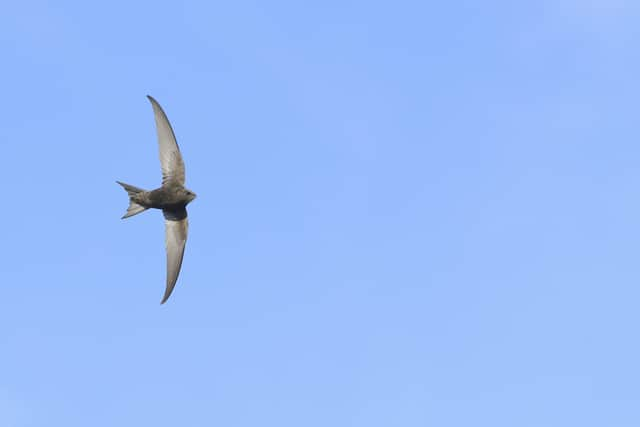RSPB COLUMN: Keep a look out for swifts this summer


The fastest bird in level flight, it can be tricky to identify a swift, as they zip high in the sky to catch insects and are easily confused with other bird species.
The simplest way to tell the difference is a swift is almost fully sooty grey, appearing black and boomerang shaped against the sky.
Advertisement
Hide AdAdvertisement
Hide AdIf you see a flash of blue or a light-coloured tummy, that is most likely a swallow or house martin.
A swift’s forked tail is also shorter than a swallow and they have a distinctive, screaming call.
You won’t see a swift perch on a telegraph wire or a fence, their legs are too short, instead they are perfectly adapted to live their life in flight.
A newly fledged swift can live for two or three years without ever landing. They eat, sleep and mate on the wing, travelling vast distances on their migratory journey from Africa.
Advertisement
Hide AdAdvertisement
Hide AdYou can spot swifts in cities, countryside and everywhere in between.
They mate for life and return to meet each other at the same nest site every spring to breed and raise their young.
Usually nesting in holes and crevices of our buildings, the modernisation of building techniques to avoid gaps in soffits and brickwork, as well as declines in their food supply of insects, has contributed to their decreased numbers.
In just 20 years, more than half of our swifts have vanished, but there are ways we can help.
Advertisement
Hide AdAdvertisement
Hide AdYou can track where they nest by using Swift Mapper, a free and easy to use online register or download the handy Swift Mapper app on your phone. By marking swift breeding hotspots, their homes can be protected or new nest sites can be created.
You could also install swift nest boxes at home to give returning and newly fledging birds a place to rest and return to.
If you are lucky enough for a swift to take up residence in your nest box you can expect a seasonal visitor time and time again.
So why not go out swift spotting and help to protect this noisy, speedy, species of summer? Visit www.swiftmapper.org.uk
Comment Guidelines
National World encourages reader discussion on our stories. User feedback, insights and back-and-forth exchanges add a rich layer of context to reporting. Please review our Community Guidelines before commenting.